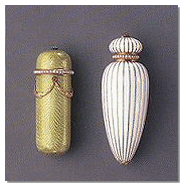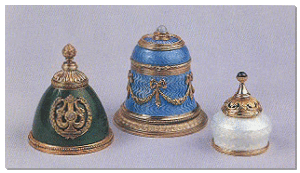
Authentic Perfume Bottles
Brooklyn Museum, New York

Fauxbergé: Perfume Bottle, Inkwell, Brush Pot
New Brunswick Museum, St. John, Canada
Authentic Fabergé objects from the House of Fabergé in Russia were not made after the Russian Revolution in 1917, when the Bolsheviks closed down the shop in St. Petersburg. In the 1930’s authentic Fabergé began appearing in the jewelry shops of Wartski in London, and in the 1940’s at A La Vieille Russie in New York City. The first Fabergé auction was held at Christie’s London in March 1934 to be followed in January 1935 by a Sotheby’s London auction. At the same time Armand and Victor Hammer began selling authentic Fabergé pieces in the United States next to fake Fabergé, or “Fauxbergé” as Dr. von Habsburg has dubbed them.
In the early 1990’s major American museums as owners of authentic Fabergé allowed licensed reproductions to be made for sale in their museum stores, and in addition, another generation of Fabergé’s, the great-grandchildren of Carl Fabergé, joined the new merchandising trend. An illustrated essay, Fabergé in the 21st Century, gives details of the many varieties on the market today.
In 2006 Pallinghurst, Ltd., acquired the Fabergé name and has ventured into selling modern high-end jewelry under the name of Fabergé.
Fabergé enthusiasts and collectors planning to purchase authentic Fabergé objects should educate themselves before acquiring a Fabergé objet d’art. The following resources are recommended:
-
Study books and exhibition catalogs about Fabergé to become familiar with the types of objects made, the hallmarks and marks used by workmasters, and learn about other Russian artistic styles of that period. A Selected Fabergé Bibliography with annotations has been compiled. In Will the Real Fabergé Stand! A Dealer’s Perspective, (Fabergé Research Newsletter, Fall 2009) Peter L. Schaffer of A La Vieille Russie suggests – “Potential buyers should remember the old advert — the quality goes in before the name goes on. People do not look at the design and quality of Fabergé objects, they just say, BUT it is signed. Marks can be added, quality cannot.”
-
Visit permanent and temporary exhibitions.
-
Purchase from reputable dealers:
- London, Bentley and Skinner
- London, Wartski
- New York City, A La Vieille Russie
- Redmond, Washington, John Atzbach Antiques
- London, Ruzhnikov Fine Art & Antiques
- Chicago, Romanov Russia
-
Visit major auction houses, ie., Christie’s and Sotheby’s in New York and London during their annual spring and fall Russian and Fabergé sales. Objects to be auctioned are on view several days in advance of the sale and experts are on hand to answer questions. Potential bidders may examine the pieces. Both of these auction houses along with those in Finland and Sweden sell illustrated catalogs individually or by subscription. Older auction catalogs may be purchased from Jeffrey Eger Auction Catalogues.
-
Be familiar with the differences between authentic, fake, and modern-style Fabergé objects. The Fall and Winter 2017 issue of the Fabergé Research Newsletter covers at length with accompanying case studies the topic of Fauxbergé – Caveat Emptor!
-
Treasure the objects for their beauty and their unique historical connection, and above all, practice caveat emptor — let the buyer beware!
